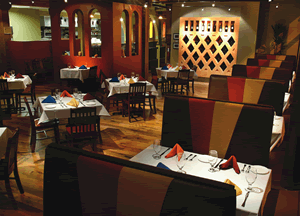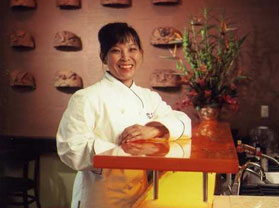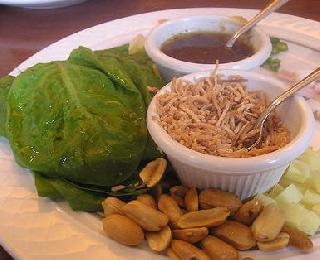 Andina (1314 NW Glisan, Portland 97209, tel. 503 228 9535) is the only Peruvian restaurant I’ve ever come across. It is, at the time of writing, one of Portland’s most popular and fashionable restaurants. I should have paid attention to this fact and booked rather than just rolling up on a Thursday night in the hope of finding a free table.
Andina (1314 NW Glisan, Portland 97209, tel. 503 228 9535) is the only Peruvian restaurant I’ve ever come across. It is, at the time of writing, one of Portland’s most popular and fashionable restaurants. I should have paid attention to this fact and booked rather than just rolling up on a Thursday night in the hope of finding a free table.
There wasn’t one, so Dr W and I ended up in the bar area, sitting hip-to-hip on a window bench at a very small table. Surprisingly, this seating arrangement turned out to be absolutely delightful; a man in a Panama hat played the guitar and sang so close to our seats it felt like he was serenading us; we tiled our table with two rounds of tapas; we were able to squish up against one another very pleasantly; and we came home filled with proximity- and music-engendered lust (and oysters). All the same, I don’t recommend the bench if you’re dining with anybody whose thighs and manly ribs you do not feel comfortable being pressed against.
Peruvian food is completely new to me. Almost all the South American food I’d tasted to date had been based around corn – Mexican tamales, nachos and a million meaty, tomato-y things wrapped in tortillas. There was the Chilean place in Madrid years ago, which I hope is non-typical, where we had rice cooked with some tomato puree, some mince, and a fried egg. Here at Andina the starches are quite different, and the emphasis switches from meat to seafood. Peruvian (or what this restaurant is calling Novoandean) food has some distinct Japanese influences as well, alongside some really interesting pre-Colombian flavours. It makes for a mixture of flavours you’ll be hard-pushed to find anywhere else. There are also some extremely handsome waiters. I like this place.
Your meal opens with a moist quinoa bread served with three ajíes, or Peruvian spicy salsas. The passion fruit and habañero one in particular is to die for – and these have enough kick to prompt you to explore the exhaustive drinks list.
Around the bar, bottles of rum lie on their sides, infusing with fruits to the accompaniment of salsa music. There are some superb cocktails on offer here (Portland seems to be a great town for cocktails), and we particularly enjoyed a frozen something called Guanabana…do doo…do doo do, which was made with banana-infused rum, guanabana puree, nutmeg and gloriously creamy almond milk. If you’re not on the booze, you’ll find yourself well catered for, with some fresh juices and concoctions like chica morada, made from purple corn, lime, pinapple and sugar syrup.
Potatoes, of course, make up a goodly proportion of Andean carbs. I wasn’t expecting them to provide colour as well, though, so the lurid violet of the Causa Morada, a cake of mashed purple potato sandwiched with smoked trout and flavoured with key lime juice, came as a real surprise. This is a visual treat, and tasted absolutely great. (Portland Food and Drink, a website I found immensely helpful in making restaurant choices in the city, has a great photo of the octopus version here.) I found the tortilla (a thick potato and onion omelette) a bit stodgy and certainly less exciting, but Dr W disagreed with me and wolfed the whole thing.
There were several oyster varieties on offer, most from the nearby Pacific coast, alongside a few Atlantic ones. We went for the local Kumamoto oysters. These are one of my favourite oysters; small, but with a deeply fluted shell, they’re juicy but not large enough to be snotty. Zingy ingredients like mangos, radish, shitake mushrooms, ginger, cucumber and more of those chillies made up the pisco rocoto, chalaquita, mango-radish and nikkei salsas served alongside, all a great foil for the richness of the little oysters.
Ají de huacatay pops up in several places on the menu, and the allergy-aware waiters will warn you that this is a peanut-based sauce. It makes for a spicy dip for deliciously fresh prawns coated with smashed quinoa and deep fried. (This is an unbelievably toothsome, crispy way to ‘breadcrumb’ food, and has inspired me to ignore my deep-seated dislike of pretend-doctor Gillian McKeith, the awful poo lady, and buy a pack of quinoa to experiment with.) The
ají de huacatay also serves as a dip for the very savoury beef-heart kabobs – slim strips of the flavourful, chewy muscle of the heart, marinated and grilled on sticks.
Chorizo was good, but I kind of wished I’d ordered something else – I love the stuff, but it wasn’t very new or exciting compared to some of the other things on the menu. Musciame de Atun (which I think was meant to come with some kind of sauce, but which arrived naked) was something I actively disliked: a cured tuna, dried and almost gamey, presented in slices. This is more likely to be my problem than the restaurant’s, though; I’ve never found a cured tuna I have enjoyed – and Dr Weasel loved it.
Everybody’s favourite South American ingredient, chocolate, stars on the dessert menu and in some great after-dinner drinks. The Torta de Chocolate was what I’ve always imagined the River Cafe cookbook’s infamous Chocolate Nemesis (a mysteriously non-working recipe which has ruined many dinner parties) should have tasted like. This made me giddy. Dense, not too sweet, unbelievably creamy, moist and rich, it’s worth a flight to Portland just to sample it. I rounded off the meal with a boozy hot chocolate drink.
Andina deserves its wall-full of awards. If you’re visiting for the first time, I’d recommend doing what we did and going for the tapas rather than the large plates, so you can get a good sampling of the unusual flavours on offer. There are vegetarian, vegan and gluten-free menus on offer as well, so you can take your picky friends.
Way back in the early 1980s, my mother used to get a magazine (now sadly defunct) called A La Carte. It was some serious aspirational 1980s stuff – all glossy pages, gorgeous photos and recipes full of exotic (for the 80s) things like sun-dried tomatoes. Long after the rest of her collection had vanished, one issue of the magazine stayed downstairs on the cookery book shelves. It was Easter, so there was a fluffy rabbit frolicking in salad leaves on the front, and a bold headline saying ‘Lettuce play’. Page upon page of salad with more bunny porn followed – along with a recipe for something called an Ooey, Gooey Sticky Toffee Pudding – the sole reason for preserving this issue of the magazine for thirty years.




